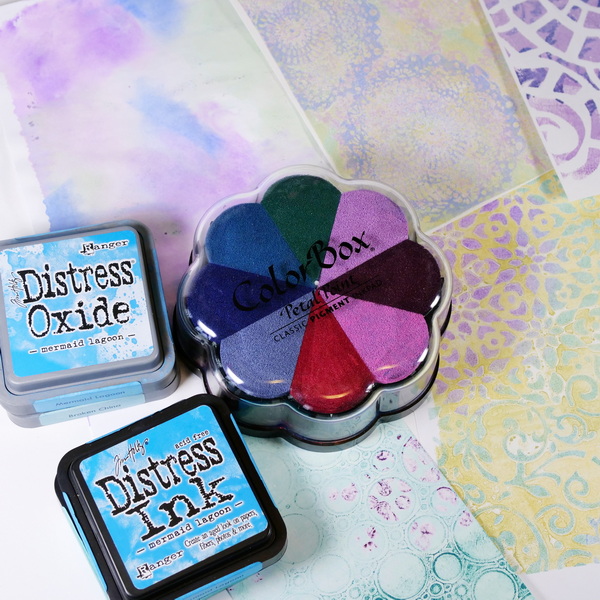
How to Create Gelli Prints with 5 Types of Ink
When learning how to create gelli prints with inks, it can be hard to know which ink to choose. There are so many to choose from. What ink is the most vibrant? What inks will stain your gel plate? Today we will cover 5 popular inks and how they work with the gelli plate on both gloss paper and cardstock.
Hop-A-Long Studio is reader-supported. When you buy through links on our site, we may earn an affiliate commission at no cost to you. Learn more.
How to Gelli Print with Inks
The basic technique to create gelli prints with inks is the same as paint. To create a beautiful print, apply ink using a blending tool or place the ink pad directly to the surface. Add stamps, stencils, or mark making to create designs. Cover with a piece of paper and pull a beautiful print.

But there are differences when using ink instead of paint. Inks will go on thinner and more translucent. Gelli printing with inks gives a very different look to the prints. This is a way of getting subtle layers of color without adding the heaviness of paint to your project.
Inks can give you very muted or vibrant color depending on the type of ink and how you apply it. One of my favorite things about using inks is the number of layers you can add to one monoprint. When using acrylic paint, you often need to add the layers individually. While with inks you can add them on one print.
Choosing the Right Ink for the Gel Plate

There are so many inks available that can be used on your gel plate, but they are not all equal. Some inks will stain your gel plate, while others are less light fast. It’s important to understand the properties of these inks before using them with your gel plate.
Pigment Inks for Gelli Printing
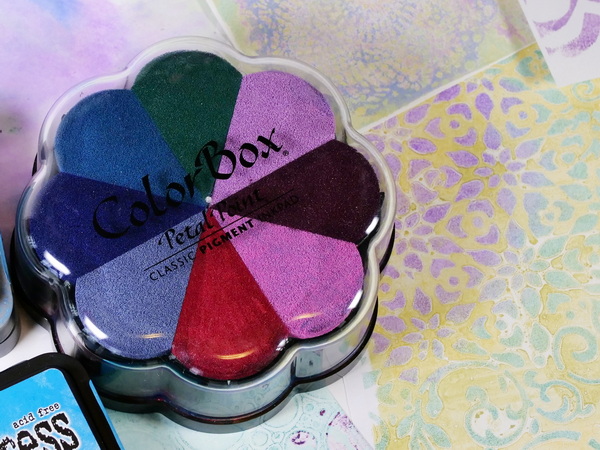
Pigment ink is one of the most light-fast inks available. It is created using ground up pigments mixed with resin, which is why the colors are more vibrant, opaque, and more colorfast than dye ink. If you intend to expose your projects to a lot of light, I would highly recommend pigment ink for your gelli prints.
Pigment inks are vibrant and blend well with other ink colors, especially when using a blending tool. As the pigment ink is opaqe and has vivid color, it is easy to see where you place your ink on the gel plate. This ink layers easily, so you can add layer after layer of pigment ink onto your gel plates to get fantastic results.
This ink works on a variety of surfaces. For this tutorial I used both glossy and regular copy paper for printing and the results were excellent on both surfaces. As the pigment ink is very intense, it is easy to get two great prints with just one application of ink.
One thing to watch for is that the pigment ink may stain your gel plate. Especially if you are using red pigments on your gel plate. Wipe the ink off the plate right after you take your prints using a baby wipe, but you may find a bit of staining due to the intensity of the pigments.
Techniques Using Pigment Ink
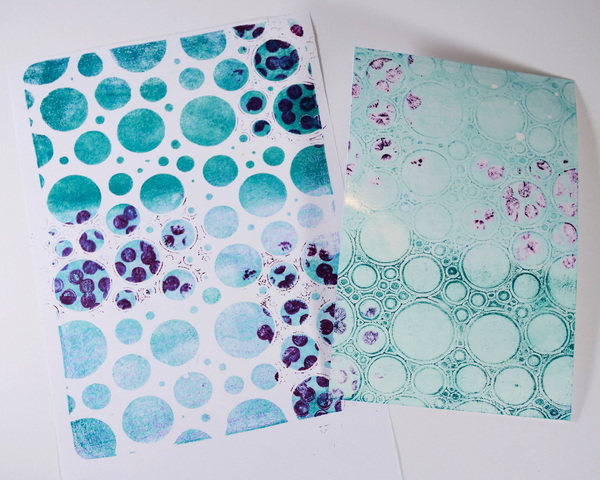
For these prints I used Turquoise, Seaglass, and Teal pigment ink straight onto the surface. I added the Mindful Moodling Swirly Moodle stencil on top of the gel plate. Using a text stamp and Orchid pigment ink, stamp on the gel plate through the stencil. Using Eggplant pigment ink and a dot stamp, stamp through the stencil again in random areas.
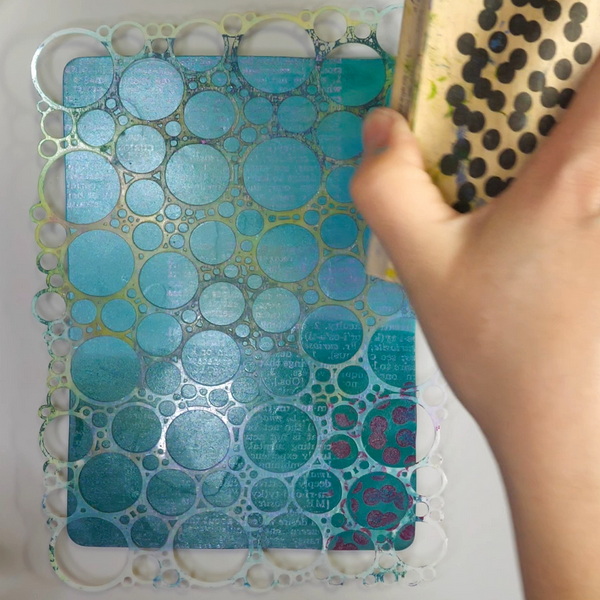
For the first print, I left the stencil on the page when taking the print. This creates a very high contrast print. For the second print, I removed the stencil before taking the print using gloss paper. You can see how this created quite a bit of variety between the first and second print. But the vibrancy of the ink shows through in both prints on both the copy paper and gloss paper.
If you are interested in buying pigment inks, the ones that I’m using are now out of production as they are more than 10 years old. I would suggest trying the Color Petal pigment inks as they are a very similar product and are made of high-quality pigment ink.
Chalk Ink for Gelli Printing

Chalk ink is considered a hybrid ink and gives a very different feel to gel prints than pigment ink. What I love most about this ink is the beautiful chalky finish and the soft look it gives to the prints. This ink is opaque and gives good coverage on the gel plate, so it is lovely for gel plate printing.
You can see from the samples below from gelli printing with these inks is that the first and second prints have excellent color. It has a softer, more chalky appearance and is different from the pigment inks.
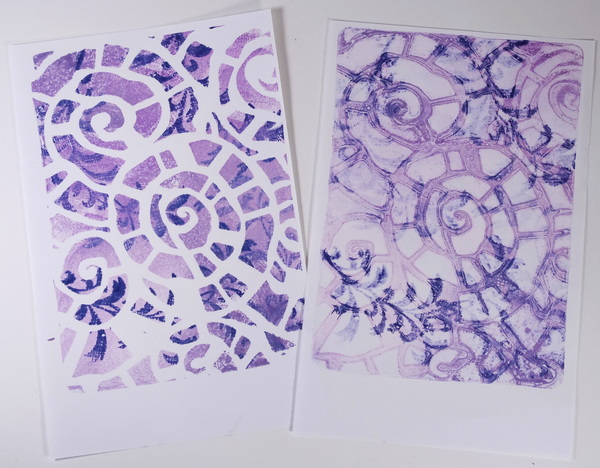
I didn’t notice any staining with these inks, but I would be careful to clean your paint right away to prevent staining.
Chalk inks have become less popular over the last few years, but they are a beautiful ink. My favorite chalk inks were created by Color Box. But as they are no longer in production, I would suggest Tsukineko VersaMagic chalk ink at Scrapbook.com for another quality brand of chalk ink pads.
Archival Ink Gel Prints
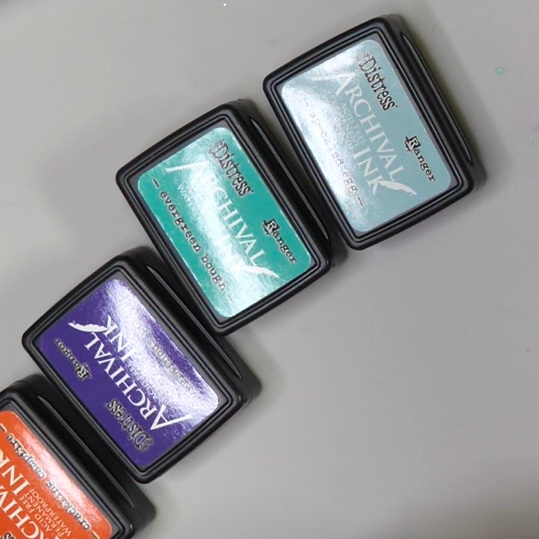
Archival ink is an oil-based ink that is vibrant and permanent. Because of the oil-based properties, it is very light fast and has beautiful solid color. You can use archival inks on your gel plate but be aware to expect A LOT of staining. You can see on my gel plate the areas that are yellow, this was from Crackling Campfire Archival Ink that did not come off my plate when I cleaned it.
But you can create beautiful prints with archival ink with vibrant colors. If you aren’t concerned about staining, you may want to try this ink on your gel plate.
Techniques with Archival Ink
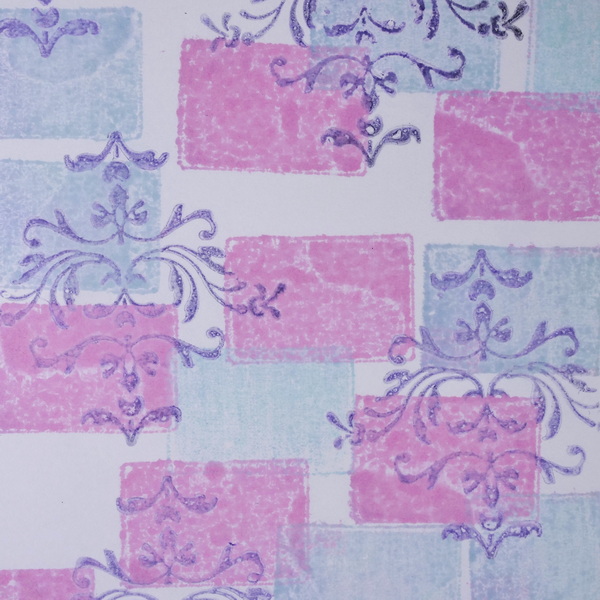
As I generally use mini archival ink pads, this can be a fun way to add mark making to your projects. You can create mosaics, or just add strong lines as you use the ink pad directly onto your project. It is a very easy ink for layering and you can get a lot of contrast. The archival ink has great contrast on both the glossy and regular paper which creates beautifully vibrant prints. For these prints I used a combination of Salvaged Patina, Evergreen Bough, Villiainous Potion, and Black Soot archival inks.
Dye Inks with the Gel Plate
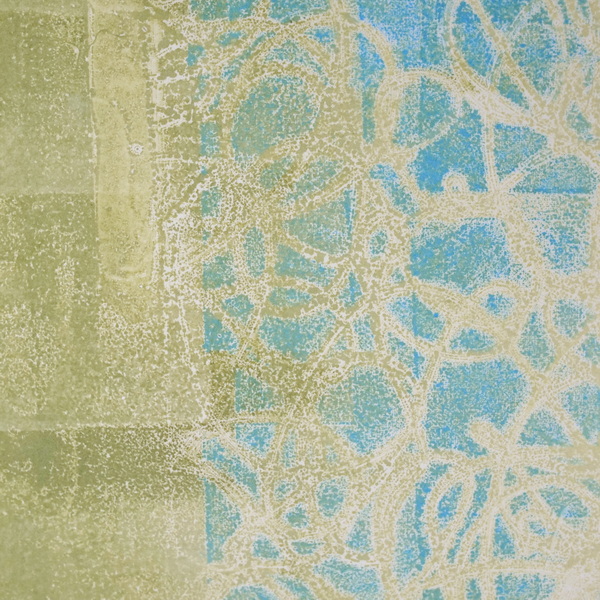
Dye inks are made using water soluble dyes but are much less light fast than pigment inks. One of the benefits of dye inks is that they blend with other dye inks beautifully and are excellent for creating custom color combinations. I tend to only use gelli printing with dye inks in journals and on projects that will not be seeing much sunlight as these inks will fade over time.
Distress inks are perfect for gelli prints with inks because of the ability to create beautiful blends. This can allow you to add many layers of ink to your prints and create complex color mixes. The dye-based inks will not stain the gel plate, which is a huge plus for these inks.
Techniques with Tim Holtz Distress Inks
My favorite dye inks are the Tim Holtz Distress Inks. These inks come in a large range of colors and blend beautifully together. Any of the techniques that can be used with pigment and chalk inks can also be used with Distress Inks.
Ink Swiping on the Gel Plate
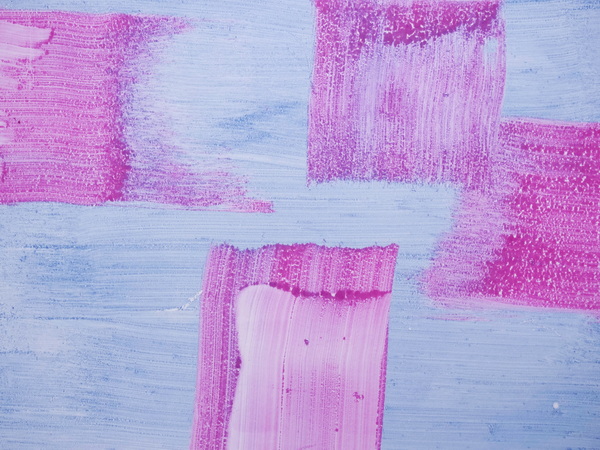
To make simple and bold designs, try swiping the Distress Inks across the gel plate. For this example, I used Picked Raspberry Distress Ink and Faded Jeans Distress Ink. The bold mark making effect can be a beautiful background or the start of a multi-layered print.
Mark Making on the Gel Plate
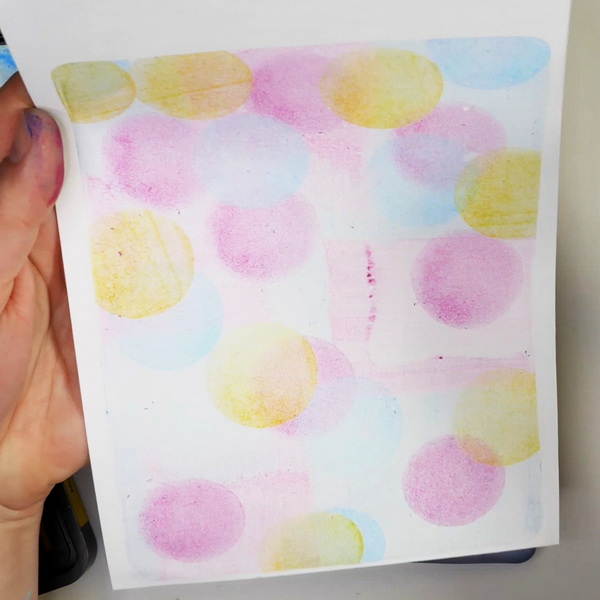
I also love using my Mini Ink Blending Tool to create circles on my gelli plate. It will be hard to see the marks when you first add them to the plate, but when taking a print, this can be a fun and random background for your next project.
Tim Holtz Distress Oxide Inks
Tim Holtz Distress Oxide Inks are another hybrid ink. The Distress Oxide ink is a dye-pigment fusion ink. When water is added to the oxide inks, they oxidize and color shift creating a chalky consistency. These inks have beautiful opacity while still blending beautifully with other colors.
Of all the inks that I use for gel printing, the Distress Oxide inks are my favorites. They don’t stain my plate and the workability and drying time of this ink works well for gelli printing.
Techniques for Distress Oxide Inks
Watercolor Techniques
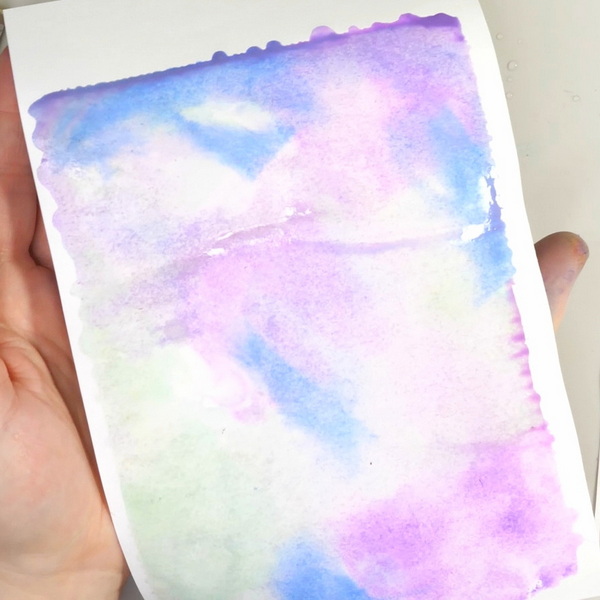
Besides being excellent for all the other techniques that I have included above, these inks can create beautiful watercolor effects on your gel plate. As these inks are reactive with water, try adding ink to your gel plate and spritz with water. Depending on how much water you add you will either get a soft print or a fully watercolor-like print from your gel plate.
Gelli Printing with Foam Stamps
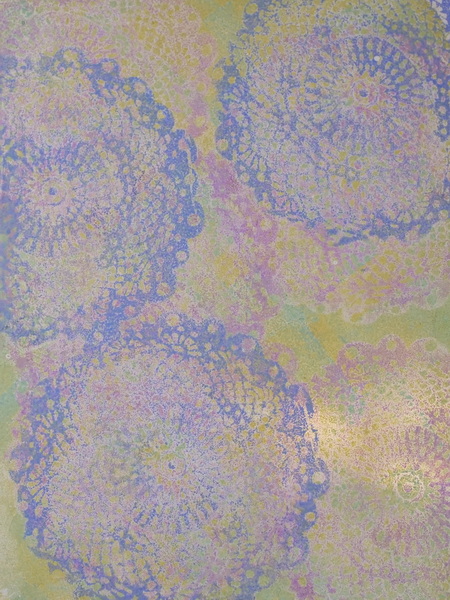
These inks also work so well with foam stamps. Try layering ink, adding stencils or other mark making and finish off with several colors of ink using foam stamps. This will create a lot of depth in your prints with the different colors and layers that are possible using Distress Oxide Inks.
Looking for More Gel Plate Inspiration?
Because I love to collage, gel plate printing is a large part of my creative practice. If you are interested in seeing more content about gelli printing, check out these articles:
How to Gelli Print on Tissue Paper
Gelli Plate Printing with Leaves
Printing with Gelli Plate Minis
Creating Beautiful Textures by Gelli Printing with Stencils
Any Questions?

I know I’ve gone through a lot of different inks as we’ve talked about creating gelli prints with inks, but I hope that this gives you the information for choosing the right ink for your creative practice. You don’t need to go out and buy every ink, I just happen to have collected a lot of inks over the last 20+ years of my creative practice!
What inks do you like to use and have you tried any of them with your gel plate? I would love to hear what you use and if you have any questions about what I shared today! Leave a comment below and I’d love to start a conversation with you!
Project Supply List
Colorbox Pigment Ink: Turquoise, Sea Glass, Teal, Orchid, Eggplant **As some of these inks are no longer available, I would recommend Color Petal Pigment Ink.
Tim Holtz Distress Archival Inks: Salvaged Patina, Evergreen Bough, Villiainous Potion, Black Soot
Colorbox Chalk Ink: Wisteria, Warm Violet, Lavender, Blue Iris **As some of these inks are no longer available, I would recommend Tsukineko Dew Drops Chalk Ink
Tim Holtz Distress Inks: Weathered Wood, Picked Raspberry, Faded Jeans, Salty Ocean, Mustard Seed, Peeled Paint, Shabby Shutters
Tim Holtz Distress Oxide Inks: Fossilized Amber, Peeled Paint, Mermaid Lagoon, Wilted Violet, Blueprint Sketch, Crackling Campfire, Cracked Pistachio, Faded Jeans
Ranger Mini Blending Tool & Domed Foam
Distress Spay Bottle
Glossy Cardstock
Copy Paper
Wild Whisper Designs Bubbles & Disjointed Stencils
Studio Light Mindful Moodling Swirly Stencil
Studio Light Grunge Masks Swirls SL-GR-MASK51 & Atelier SL-GR-MASK51
Tim Holtz THS072 Doodle Stencil
Rubber Stamps
Foam Stamp Doily Design



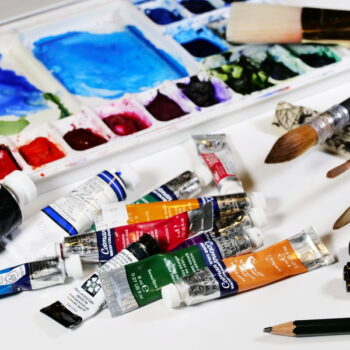
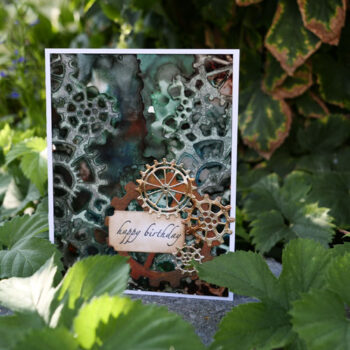
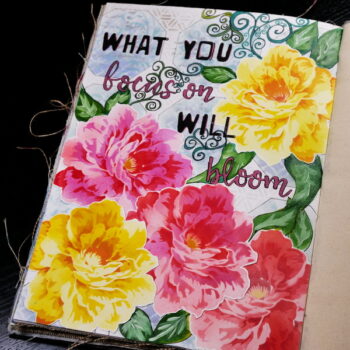
4 Comments
BELINDA FROST
Can I use Block ink on a Gelli plate?
Nadine Milton
I haven’t tried block ink myself, but give it a try! I find a lot of inks work, the question is will they stain your gel plate. It also depends on what the base ingredients of your block ink is. Every ink will react differently but I hope that you give it a try. I’d love to hear what results you get!
Ineke
Kun je ook met Oost-Indische inkt printen op de gelplaat?
Nadine Milton
I haven’t tried it myself, but I think it should work well. The only concern that I would have is that it may dry quickly and not transfer. But if it does, you could always add a layer of paint or medium to pick up the ink from the plate and still get a great image.